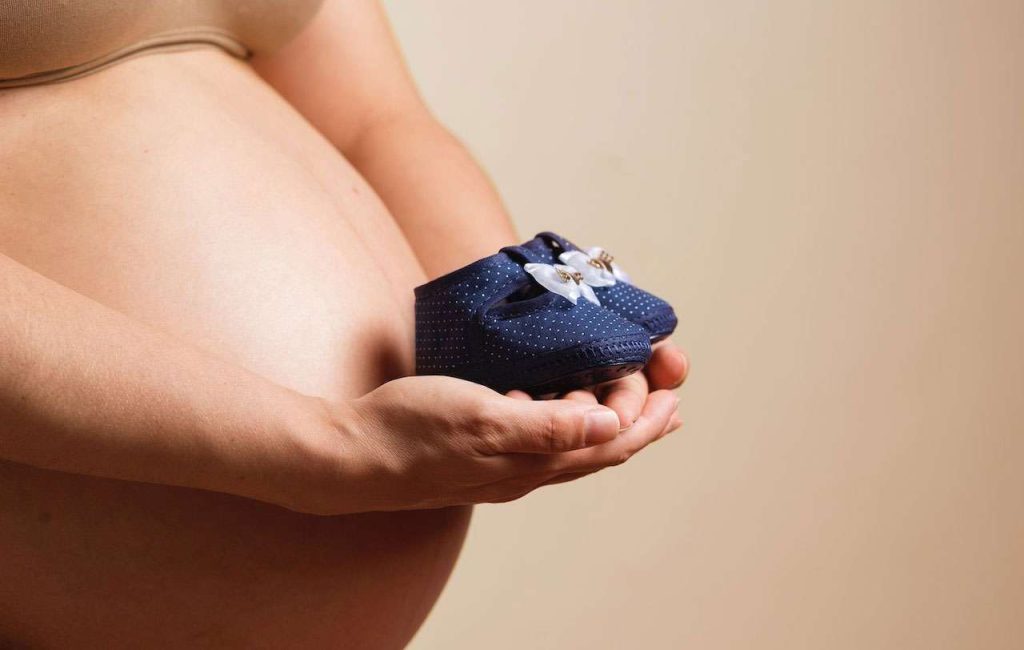Some people may experience a change in their shoe size during these life events, while others may not notice any difference. Find out more about how it could change below.
Can shoe size increase during pregnancy?
There is inconclusive evidence on whether pregnancy can affect shoe size. Some women report that their feet do indeed grow during pregnancy, while others claim no change in shoe size.
One potential explanation for foot growth during pregnancy is the increase in weight and pressure on the feet, according to this study. This added weight can cause the ligaments and tendons in the feet to stretch, potentially leading to longer and wider feet.
It is important for pregnant women to pay attention to any changes in their foot size and get properly fitted for new shoes as needed. Wearing shoes that are too small can lead to discomfort and potential foot problems. Pregnant women should also make sure to wear comfortable, supportive shoes to help with any added pressure and weight on the feet.
It is important to note that individual experiences may vary, and some women may not experience any changes in their shoe size during pregnancy. It is always best to consult with a healthcare provider for personalized advice and guidance.
Overall, it is possible for shoe size to change during pregnancy. Pregnant women should pay attention to any changes and make sure to wear properly fitted, comfortable shoes for added support.

After pregnancy
Some women report that their shoe sizes do change after pregnancy. This can be attributed to a number of factors, including weight gain, water retention, and hormonal changes that can affect the shape and size of feet.
It is important for pregnant women to pay attention to any discomfort in their feet and consult with a healthcare provider about proper shoe fit. Wearing shoes that are too small can lead to foot pain and potential injury. It may be necessary to invest in new shoes during pregnancy and after childbirth. Because the structure of your foot can permanently change, according to this study.
However, it is important to note that not all women experience changes in shoe size after pregnancy. Each person’s body and experience is unique, and it is possible for shoe size to remain the same or even decrease after pregnancy.
In any case, it is always important for women (and all people) to wear properly fitting shoes and pay attention to any discomfort in the feet. Consulting with a healthcare provider and possibly investing in new shoes can help alleviate foot pain and potential injury.
Do you like to know more about shoe sizes for babies and kids? Check out the other article we wrote.
Shoe size change with weight loss
Weight loss can lead to a decrease in shoe size as well. This is because when we lose weight, not only do our bodies shrink in overall size, but the fat and tissue around our feet also decreases. As a result, our feet may become slimmer and require a smaller shoe size to fit comfortably.
However, it is important to note that weight loss is not the only factor that can lead to a change in shoe size. Age, pregnancy, and medical conditions can also affect the size and shape of our feet. It is always a good idea to get your feet measured periodically to ensure you are wearing the proper shoe size for your current foot shape and size.
Additionally, keep in mind that while losing weight can lead to a smaller shoe size, sudden and excessive weight loss can also harm your feet. Rapid weight loss can weaken the muscles and ligaments in your feet, leading to pain and injury. It is important to maintain a healthy and steady weight loss journey to not only benefit your overall health, but to also protect your feet.
If you do experience a change in shoe size with weight loss, be sure to get your feet re-measured and invest in proper fitting shoes to support and protect your feet. Happy (and healthy) stepping!
Note: This content is meant to be used as additional information, not to be copied verbatim. Always consult with a healthcare professional before beginning any weight loss journey.
How much weight do I have to lose to go down a size?
It depends on a variety of factors, including your height, current weight, body composition, and the sizing system of the shoe brand you are referencing. Generally speaking, shoe sizes may vary significantly between brands and even within the same brand.
Losing weight in the form of muscle versus fat can also affect size. In short, the best way to determine what size you may fit into after losing weight is to try on and see how it fits, rather than focusing solely on the number on the scale.
Last but not least, it is important to focus on overall health and well-being rather than a specific size.
Change after the age of 30
As we age, our feet tend to get longer and wider. This is due to a combination of factors such as the wearing down of our foot pads, joint changes, and weight gain. As a result, many people find that their shoe size increases after the age of 30.
It’s important to regularly check and update your shoe size, as wearing improperly fitting shoes can lead to discomfort and even foot injuries. So next time you go shoe shopping, make sure to try on a few different sizes to find the best fit for your feet. And don’t be afraid to size up! Your feet will thank you in the long run.
Final reflections
One potential reason for a change in shoe size during weight loss is that the fat pads on the feet may shrink, resulting in a slightly different measurement. Pregnancy can also cause changes in the feet due to added weight and hormonal effects on the ligaments.
As we age, our feet may become longer and wider due to wear and tear on the joints and ligaments. This can lead to a change in shoe size over time.
However, it is important to note that these changes in shoe size may not be significant or noticeable for everyone. It is a good idea to periodically check and update your shoe size to ensure proper fit and comfort.
Additionally, keep in mind that shoe size can vary between brands and styles. It is best to try on multiple sizes and styles to find the best fit for your feet.
Weight loss can also lead to a change in shoe size, as the feet may shrink in size due to loss of fat and muscle. However, it is important to recognize that this change may not occur immediately and may take time.
Similarly, pregnancy can result in temporary changes in shoe size due to added weight and hormonal effects on the feet.
As we age, our feet can also change in size and shape due to wear and tear and loss of fat and muscle. This is why it is important for older individuals to regularly check their shoe size and update as needed.
Overall, changes in shoe size can occur due to various factors such as weight loss, pregnancy, and age. It is important to regularly check and update shoe size to ensure proper fit and comfort.

